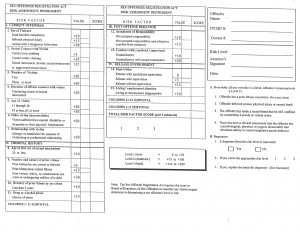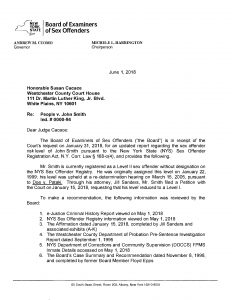How to Lower Your SORA Sex Offender Registration Level
When a person convicted of a sex offense is sentenced, or when that person is released from prison, there will be a hearing to determine his or her level of registration pursuant to the Sex Offender Registration Act (“SORA”). This level is meant to represent the person’s risk of re-offense and dangerousness so that the community can be notified accordingly.
The New York State Legislature has recognized that people subject to SORA can make positive changes in their life which lowers their risk of recidivism and threat to society. A registrant may petition a court to lower his or her risk level, or even ask to be relieved from the duty of registration in some circumstances.
The Basics of SORA
At an initial risk-level determination proceeding pursuant to SORA, the prosecution or the Board of Examiners of Sex Offenders (“Board”) will score a Risk Assessment Instrument (“RAI”) to determine a registrant’s presumptive level. The RAI considers the facts of the offense, the registrant’s criminal history, and many other factors.
Risk Assessment Instrument
The prosecution or Board will use the RAI to make a recommendation to the court as to what the registrant’s risk level should be. The Court will then conduct a hearing at which the registrant can challenge the recommendation; the hearing is often called a “SORA hearing.” The registrant can also submit additional evidence in his or her favor which demonstrates a lower risk of re-offense.
After considering all of the evidence, a judge will make a determination whether the registrant should be adjudicated a Level 1 (low risk), Level 2 (moderate risk), or Level 3 (high risk) offender. The judge must also make a determination whether the registrant should be designated a “sexually violent offender,” “predicate sex offender,” or “sexual predator.”
Every year, each registrant must verify his or her personal information, including home address and vehicle information, with the Sex Offender Registry. Level 1 registrants must check in with their local law enforcement once every three years, while some registrants – including Level 3 registrants and those designated as “sexual predators” – have to check in every 90 days. Level 2 and 3 registrants are also pictured on the Internet with their home and work addresses listed as well as vehicle information.
Who Can Petition for Modification or Relief?
Every year, any registrant adjudicated a Level 2 or Level 3 offender can petition for modification of his or her SORA risk level. The registrant must petition the Court, setting forth the level sought, and demonstrate by clear and convincing evidence the reasons for the modification. Note, however, the law does not provide for changing a registrant’s designation.
Level 1 registrants only have to register for 20 years; after that period of time, he or she will automatically be removed from the registry. Any Level 2 registrant without a designation who has been registered for 30 years or more can petition for relief from being required to register; this petition can only be done once every two years. Level 3 registrants and any person with a designation (regardless of their risk level) must register for life.
A prosecutor can also petition a court in order to increase a defendant’s SORA registration level. This petition must set forth that the defendant committed a new crime or engaged in some other conduct that indicates an increased risk of recidivism.
How Does the Petition Process Work?
A registrant must submit to the Court a Notice of Petition, along with a Petition setting forth the reasons why modification or relief is warranted. The Petition should include evidence in order to prove by clear and convincing evidence that a registrant is now a lower risk or why the registrant should be relieved of his or duty to register.
The Court will then send the registrant’s Petition to the Board. The Board must within a certain period of time review the Petition and provide a recommendation to the Court as to whether modification or relief is warranted.
Sample Board Recommendation
Upon receipt of the Board’s recommendation, the Court will send the recommendation to the prosecution and the registrant. The prosecutor will then have an opportunity to weigh in on the registrant’s petition. At the modification hearing, the Court will consider all the arguments and allow the prosecution and the registrant to introduce additional evidence and make arguments about whether modification or relief is warranted. The Court will then make findings of fact and a conclusion as to whether to grant the registrant’s petition. Many times, a Court will adjourn the matter after the hearing and issue a written decision.
What Kind of Factors Show a Reduced Risk Level is Warranted?
Every case is different, and you should consult with an attorney who is experienced in SORA modification petitions to determine what is best for you. However, there are several factors which courts have found to demonstrate a lower risk.
- Time spent offense-free in the community
- Successfully completing parole, post-release supervision, or probation
- Updated assessment by a psychologist or psychiatrist
- Compliance with SORA registration
- Completion of sex offender treatment
- Completion of drug or alcohol abuse treatment, and/or continued sobriety
- Advanced age
- Employment
- Education
- Family support and established social network
- Physical disabilities
References
- Correction Law § 168-o
- New York Sex Offender Registry, “Frequently Asked Questions.” Available at: http://www.criminaljustice.ny.gov/nsor/faq.htm (last accessed October 10, 2018).


